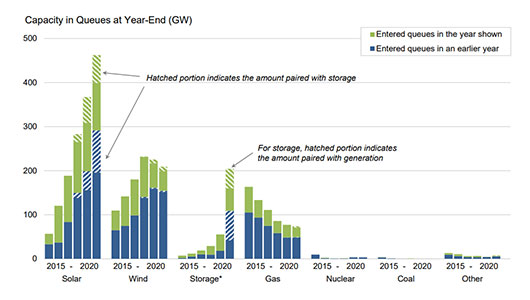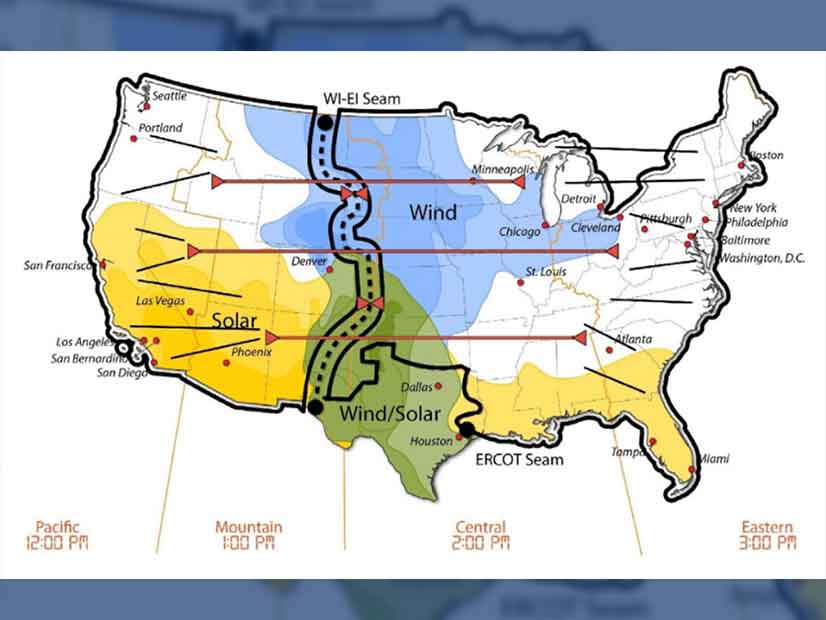FERC on Thursday opened a rulemaking to reconsider its rules on transmission planning, cost allocation and generator interconnection, acknowledging that Order 1000 has failed to provide interregional expansions to deliver increased renewables and meet the challenge of climate change.
Republican commissioners Mark Christie and James Danly joined Chairman Richard Glick and Commissioner Allison Clements, both Democrats, in supporting the Advanced Notice of Proposed Rulemaking (RM21-17). Republican Commissioner Neil Chatterjee, whose term expired June 30 and is now job hunting, did not participate.
“We are concerned that existing regional transmission planning processes may be siloed, fragmented, and not sufficiently forward-looking, such that transmission facilities are being developed through a piecemeal approach that is unlikely to produce the type of transmission solutions that could more efficiently and cost-effectively meet the needs of the changing resource mix,” Glick and Clements said in a joint statement. “Regional transmission planning processes generally do little to proactively plan for the resource mix of the future, including both commercially established resources, such as onshore wind and solar, as well as emerging ones, such as offshore wind. We are also concerned that current regional transmission planning processes are not sufficiently integrated with the generator interconnection processes, and are overwhelmingly focused on relatively near-term transmission needs, and that attempting to meet the needs of the changing resource mix through such a short-term lens will lead to inefficient transmission investments.”

Glick noted that of the 750 GW of generation in interconnection queues in the U.S., 700 GW (93%) are renewable projects, many of which are located far from load centers to take advantage of strong winds and cheap land.
“In my opinion, we need a transmission planning process that better takes into account the various resources that are going to be built in the future and better recognizes the beneficiaries,” Glick said during the commission’s open meeting.
Clements said consumers are being denied access to wind and solar that is often cheaper than natural gas and other generation sources. “In most regions, transmission is the bottleneck right now, and it’s stifling competition,” she said.

Clements said the ANOPR was “a product of compromise” with the Republican commissioners. “But in there, we are asking the important questions, and I am confident that the ANOPR will yield an informative record on which to assess the next steps. Addressing these challenges is not easy. But the need for action is clear and urgent.”
Christie noted it has been nearly 10 years since the commission approved Order 1000, which opened some transmission development to competition and required planners to consider transmission needs driven by public policy requirements. But it has been viewed as a disappointment by many because it failed to produce any interregional transmission projects.
“There’s been successes under Order 1000, everybody knows that. Everybody also knows there’s been problems under order 1000,” Christie said. “The interconnection queues are, I think to put it charitably, a mess. And that is a problem that needs to be addressed.“
Christie said the NOPR includes “a number of very good proposals” as well as some he said could “cause a massive increase in consumer bills and just transfer massive amounts of wealth from consumers to developer interests without ensuring that there is commensurate benefit.
“This is the beginning of a very long process,” he added.
Danly also expressed concern over potential costs.
The ANOPR solicits input on several questions:
-
-
- how to accommodate anticipated future generation within the regional transmission planning and cost allocation processes;
- whether the commission should require transmission providers to identify geographic zones with the potential for developing large amounts of renewables and plan transmission to integrate those resources;
- whether changes are needed to improve the coordination between the regional transmission planning and cost allocation and generator interconnection processes;
- how to allocate the costs of new transmission in a way that allocates costs “at least roughly commensurate” with estimated benefits; and
- whether participant funding of interconnection-related network upgrades may be unjust and unreasonable and whether FERC should eliminate rules that allow RTOs/ISOs to use participant funding for interconnection-related network upgrades.
-
Comments will be due 75 days after publication in the Federal Register with reply comments due 30 days after that.
“We anticipate that this effort will be the commission’s principal focus in the months to come,” Glick and Clements wrote. “In addition to reviewing the record assembled in response to today’s order, we intend to explore technical conferences and other avenues for augmenting that record — including through the joint federal-state task force — before proceeding to reform our rules and regulations.” (See FERC Sets Federal-State Taskforce to Spur New Tx.)
Reaction
Rob Gramlich, executive director of Americans for a Clean Energy Grid, praised FERC’s action. “The world has changed, and transmission planners need to plan for today’s and tomorrow’s world, not yesterday’s,” he said.
“Today’s announcement begins a welcome process that, if carried through, will help catalyze the development of a modern and resilient clean energy grid,” said Gregory Wetstone, CEO of the American Council on Renewable Energy. “… As FERC starts tackling regional issues, we look forward to future commission action on interregional processes necessary to connect centers of high renewable resources with centers of high electric demand.”
Wetstone also urged President Biden “to expeditiously nominate a fifth FERC commissioner [to replace Chatterjee] to ensure the continuity and progress of the commission’s important work.”
Larry Gasteiger, executive director of the trade group WIRES, called FERC’s action “a monumental effort that has the potential to be very impactful and could amount to, as Chairman Glick pointed out, the most significant transmission reform in more than a decade.”
Gasteiger also endorsed Chatterjee’s dissent from the commission’s decision to reject Dayton Power & Light’s request for a 50 basis-point adder to its return on equity for participating in PJM (ER20-1068). The commission ruled 3-2 that Dayton’s membership in the RTO is not voluntary because Ohio law requires it. Danly joined Chatterjee in dissent.
In April, FERC issued a rulemaking proposing to limit the adder to the first three years of RTO membership (RM20-10). That vote — also 3-2 — reversed Chatterjee’s proposal to double the adder to 100 basis points. (See TOs, Consumer Groups Clash over RTO Adder.)
Chatterjee said the commission needs to “finalize an incentives policy, including an RTO adder, to stimulate what [transmission] we need more than ever.”
“I implore the commission to move quickly to put in place a comprehensive transmission incentives policy, including an appropriate RTO adder, that advances the commission’s long-standing policy objectives and incentivizes what is needed now more than ever — investment in transmission infrastructure and robust organized markets,” Chatterjee said in his dissent in the Dayton ruling.



